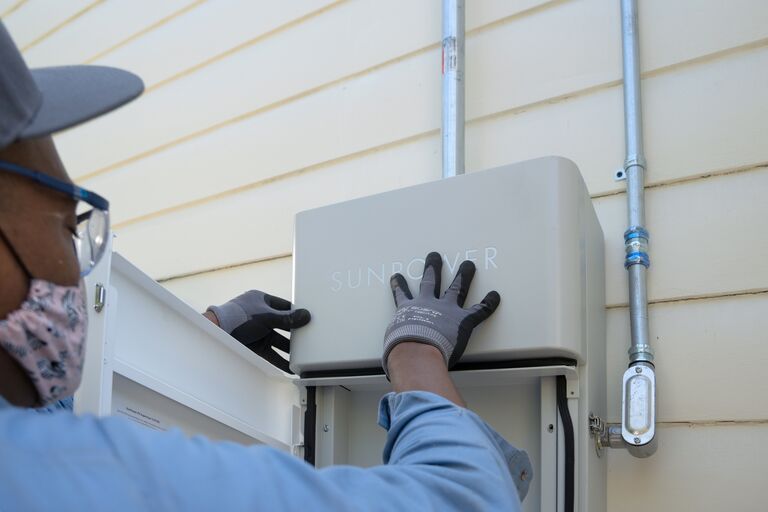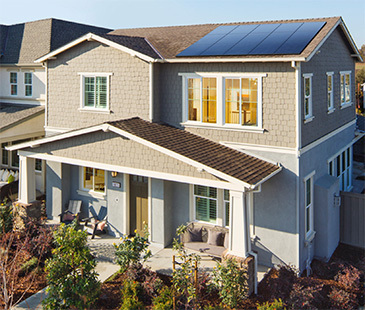
Editor’s Note: In 2020, SunPower announced the completion of the strategic spin-off of its manufacturing division into a separate business named Maxeon Solar Technologies, Ltd. As a result, SunPower has expanded its offerings to drive future growth. The SunPower Equinox® system now offers multiple panel options, including front- and back-contact panels, all of which are responsibly and rigorously quality tested to provide the best energy solution for your home.
The concept of electrification is nothing new. The movement has grown from its humble beginnings in 1752 with a kite and key, through the monumental Rural Electrification Act in 1936 to what we now know in modern times. But as the electric grid has evolved, so have the thoughts of industry leaders on its environmental impact.
Beneficial electrification refers to replacing systems that still use gas and oil with carbon-free alternatives. This includes replacing traditional HVAC systems with heat pumps, using solar + storage solutions to power your home and opting to drive an electric vehicle. While these green technologies are equipped to sustain a cleaner electric grid, there’s still plenty of work to do when it comes to their adoption. To truly make an impact on the fight against climate change, consumer adoption is key and electrification is the clear path forward.
Solar energy is an incredibly important part of the sustainable electrification movement and yet less than 3% of households use it. Luckily, it has also become increasingly affordable. A recent report from EnergySage states that costs are down 6.3% since July of 2020. The downward trend of solar system prices has encouraged many homeowners to make the switch. Incentives like the extension of the ITC are also helping drive consumer demand.
Solar panels not only help reduce the amount of carbon emissions from fossil fuels, they also help support the electrical grid. When homeowners produce their own power during peak times, they can play a role in reducing strain on the grid. This is especially true when solar power is paired with a storage solution like SunVault® storage. With SunVault storage, homeowners who have SunPower® solar can choose how to use the excess power produced by their solar panels, by selling it back to the utility company (in areas where net metering is available), activating power from their battery during peak demand times, or powering up essential appliances during a blackout.*“Essential Appliances” typically include lights, select appliances and outlets. Battery storage system should not be relied upon as a power source for critical medical devices. The battery’s ability to power your home during an outage will vary depending on factors including: the amount of energy stored in the battery, wattage used by appliances and devices powered by the battery, the ability to recharge during daylight hours due to weather, the frequency and duration of usage, and other factors.
SunPower recently conducted a nationwide survey of 1,500 homeowners and found that homeowners in 2 of every 5 households worry about power outages on a monthly basis. Of those considering solar, 70% said they plan to include a battery energy storage system. More homeowners are discovering the benefits that come with solar + storage solutions. That’s why states like California have integrated solar into new home energy codes. The California Energy Commission recently approved a mandate for developers to install 240-volt outlets in all new homes, to support electric-vehicle chargers and solar batteries. Proposals to the Title 24 energy code from the CEC are also encouraging home builders to use electric-powered heat pumps in new single-family homes.
With initiatives towards electrification and the help of local policymakers, a more sustainable future can be achieved quickly and affordably. Especially since many of these modern appliances are more energy-efficient. But even if you don’t have plans to buy a new home, you can easily achieve electrification by replacing appliances with eco-friendly versions as they phase out. For example, if your HVAC system will soon be out of date, consider choosing a heat pump to take its place.
We rely on so many different forms of technology in our day-to-day lives. From charging up our mobile phones to the convenience of running the dishwasher, we are constantly consuming energy. The demand for electricity isn’t going to decrease. That’s why it’s important to be aware of where our energy comes from and how clean it is. The more we work together to offset carbon emissions, the better off we will all be.

